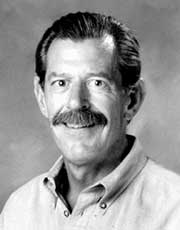David S. Saurman
Remembering Dave Saurman
 In 2002, the Economics Department not only lost an esteemed colleague and dear friend,
but students lost an inspirational teacher. Dave was a superior economist who taught
his students solid positive economics not ideology. When he wasn't in the classroom
demanding the most from his students, he was on a sunny bench entertaining all with
anecdotes.
In 2002, the Economics Department not only lost an esteemed colleague and dear friend,
but students lost an inspirational teacher. Dave was a superior economist who taught
his students solid positive economics not ideology. When he wasn't in the classroom
demanding the most from his students, he was on a sunny bench entertaining all with
anecdotes.
Dave was a consummate raconteur. Along with his students, he created the Barstool Economist group. The tradition of faculty, guest speakers, and students meeting at a local pub, continues to this day. In his memory, the Department dedicated the Provocative Lecture Series as a memorial. Dave was known for being an individualist: a man who didn't mold his choices to the will of the politically correct. He combined a provocative nature with good will and humor.
The Department also established the David S. Saurman, Most Valuable Player of the Department perpetual plaque. Each year, winners in the Faculty/Staff and Student categories receive an engraved glass beer stein. The award is not for professional scholarship or grade point average. It is for the contribution made to the quality of life in the department. As Dave liked to say, “We maximize utility, not dollars.”
A Short Biography
After graduating from Albion College in December, 1973, Dr. Saurman worked unloading railroad cars and loading trucks, as a roofer, and briefly as a stagehand/setup/gopher for Jimmy Buffett's (then largely unknown) Coral Reefer Band in New Orleans, Louisiana. Married in May, 1974 to Marcia L. Youngdahl, he entered graduate school in September, 1974, receiving a Ph.D. in Economics in May, 1979 with acceptance of his doctoral dissertation “A Transactions Demand for Foreign Exchange,” directed by Professor Thomas R. Saving.
In September, 1979 he accepted a position on the Economics faculty at Auburn University. In 1987, he joined the Economics faculty at San José State University where he was promoted to Professor of Economics in August, 1999 and was employed at the time of his death. Eight of his undergraduate students have progressed, or will progress, to earn a Ph.D. in Economics.
Dr. Saurman was published in such scholarly journals as the Journal of Law and Economics, The Review of Economics and Statistics, Economic Inquiry, Public Choice, Applied Economics, the Southern Economic Journal, the Journal of Forensic Economics, and the Journal of Money, Credit, and Banking. He has presented numerous research papers at the annual meetings of the American Economic Association, Southern Economic Association, and Western Economic Association International.
He said that he was influenced, both professionally and personally, in the most positive of fashions by fellow Economists and his colleagues in the Economics Department. However, he always claimed that he learned the most important things from Marcia Saurman.
Publications
- “Efficiency Effects of Exclusive Territories: Evidence From the Indiana Beer Market,”
with Tim. R. Sass, Economic Inquiry, July, 1996.
- “Advertising Restrictions and Concentration: The Case of Malt Beverages,” with Tim
R. Sass, The Review of Economics and Statistics, February, 1995.
- “Instant Winners: Legal Change in Transition and the Diffusion of State Lotteries,”
with John D. Jackson and William F. Shughart II, Public Choice, September, 1994.
- “Mandated Exclusive Territories and Economic Efficiency: An Empirical Analysis of
the Malt Beverage Industry,” with Tim R. Sass, Journal of Law and Economics, April, 1993.
- “Smoking and Absenteeism,” with Richard. W. Ault, Robert. B. Ekelund, Jr., John. D.
Jackson, and Richard. S. Saba, Applied Economics, April, 1991.
- “Estimating Earning Capacity With Constant Earnings Growth Rates,” with T. S. Means,
Journal of Forensic Economics, December, 1989.
- Advertising and the Market Process: A Modern Economic View, with R. B. Ekelund, Jr. (San Francisco, California: The Pacific Institute, May, 1988). Also published as Publicité et Économie de Marché, translated to the French by Guy Millière (Paris, France: Litec, 1992).